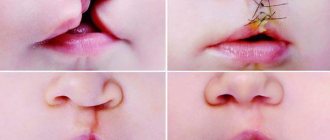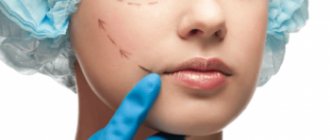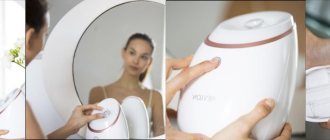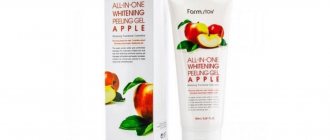Phenol facial peeling: what is it?
Under phenol peels
refers to skin exfoliation procedures performed using carbolic acid (phenol).
Traditional components of phenol peeling compositions are:
• phenol • glycerin • propylene glycol • oil, which accelerates the absorption of carbolic acid into the epidermis • distilled water
Depending on the degree of phenol concentration in the peeling preparation used, the following are distinguished:
• drugs for mid-superficial action (3% carbolic acid) • drugs for medium action (25% carbolic acid) • drugs for deep action (more than 35% carbolic acid)
One of the features of phenol peeling is its high toxicity. Therefore, deep phenol exfoliation is recognized as a dermatosurgical procedure that requires the unconditional skill of a specialist doctor. Deep phenol peeling is performed only after a thorough medical examination of the kidneys, liver and cardiovascular system, under intravenous anesthesia, with cardiac monitoring, accompanied by an anesthesiologist.
Deep peeling affects all layers of the epidermis, right down to the papillary layer. The extreme length of the rehabilitation period, reaching 12 months in some cases, and the high risk of severe complications require a particularly careful approach.
Despite the fact that phenol peels are often called the “gold standard” of aesthetic medicine and the most radical non-surgical method for eliminating wrinkles, recently, in accordance with the recommendations of the scientific community, deep phenol peels are performed only on small, most affected areas of the skin. In other areas, they are limited to median exfoliation.
For purely cosmetic purposes, phenol peeling is recommended only in cases where there is no other alternative. For example, in situations where the patient has a complex cosmetic defect that seriously impairs the quality of life. At the same time, absolute contraindications for the use of laser treatment and dermabrasion have been identified.
What effect to expect
Carbolic peeling guarantees high results very quickly. It has a beneficial effect on the functioning of skin cells and stimulates internal processes, including collagen production. Reviews from patients confirm the wonderful transformation of the skin after phenol peeling.
After the peeling procedure, the following changes occur in the skin:
- The rate of cell regeneration accelerates;
- The elasticity and firmness of the fibers of the skin are restored;
- The cells begin to actively function;
- Pigment spots disappear;
- The skin tone is evened out, they look fresher and younger;
- The relief of the face is smoothed out, small and medium wrinkles, scars and post-acne completely disappear;
- The contours become clear and toned;
- A pronounced lifting effect is observed.
It is difficult, but realistic, to believe in such a wide range of effects of phenol. A high result and restored youth justifies the complexity of the procedure, its toxicity and danger.
Indications and contraindications for phenol peeling procedures
Indications for the use of phenol peeling:
• the presence of serious age-related changes in the form of deep wrinkles and folds • photoaging • the presence of significant hyperpigmentation • tissue scarring • the need for recovery after serious surgical interventions accompanied by lumpy scars • finely wrinkled type of aging • sagging skin • severe damage to demodicosis • severe damage to acne
Contraindications in this case include:
• age under 18 years • pregnancy • lactation • presence of burns • exacerbation of herpetic disease • presence of cardiovascular diseases • presence of IV-VI phototype of the skin according to Fitzpatrick • individual intolerance to the components of phenol peeling • diabetes mellitus • presence of cancer • presence of skin diseases (eczema, psoriasis, atopic dermatitis) • menstrual period • the presence of elevated body temperature, regardless of the cause • infectious diseases • mental illnesses • thyroid pathology • periods of intense insolation • individual meteosensitivity • the need to take isotretinoin in the next 6 months preceding the peeling procedure • the presence of kidney disease and liver • fungal diseases • violation of the integrity of the epidermis • any trauma in the area of intended treatment • the presence of numerous nevi • hypertrichosis • tendency to keloid scars • impaired skin sensitivity
A conditional contraindication is considered to be age over 60 years, due to the fact that in older people the activity of liver enzyme systems is significantly reduced.
Indications for use
Phenol peels are the most radical type of skin cleansing and rejuvenation, which does not require surgical intervention, but is performed by exposing the epidermis to a chemical composition. To carry out the phenol procedure, it is important to have the following indications:
- Disadvantages of facial relief (deep expression and age wrinkles, stretch marks, scars after surgery);
- Rapid withering of the skin, loss of turgor and tone;
- Symptoms of photoaging of the skin;
- Hyperpigmentation on the face, residual marks after sunburn;
- Consequences of acne, demodicosis;
- A number of dermatological diseases (certain types of keratosis).
Phenol peeling is a confident step to restore the youth of your face. Rest assured, you will experience renewed skin that is soft and supple. The face becomes perfectly smooth and toned, just like 10 years ago. At the same time, the active synthesis of your own collagen and elastin is launched, so the result lasts for another ten years.
Pros and cons compared to other types of peeling
pros
• the ability to carefully control the application of the composition • the presence of the most pronounced anti-aging and therapeutic effect in comparison with all other types of peelings • the presence of a prolonged result that lasts for 7-10 years; • one-time procedure
Photos before and after phenol peeling
Results of phenol peeling
The positive visual effect after deep phenol peeling lasts about 10 years, and it consists of:
• in the normalization of skin functions • in a significant rejuvenation of the skin (according to some data for 5-15 years) • in a significant improvement in the structure of the skin: it becomes smooth, fresh, elastic, elastic, light, tender • in the elimination of age spots • in the elimination of deep wrinkles and scars • in the elimination of small facial wrinkles • in increasing the overall skin tone • in activating the systems of the human body at the microcircular, neural, humoral levels
Minuses
• the presence of a huge list of contraindications • the presence of a very long rehabilitation period (after superficial exfoliation it can be about two weeks, and after deep exfoliation it can reach 12 months) • the need for a thorough preliminary medical examination • the need for serious pre-peeling preparation • placing a significant load on the cardiovascular and excretory body systems • painfulness of the procedure • the need for anesthesia (for superficial exposure - local anesthesia, for deep exfoliation - intravenous anesthesia) • the need for cardiac monitoring during the procedure • the risk of severe complications
Rehabilitation period and possible complications
The pain of the procedure is felt immediately after the anesthesia wears off. The doctor prescribes pain relief medications for the first couple of days. After the barrier mask with particles of destroyed skin is removed, the face needs protective care, which is selected for a specific patient.
For the formation of a healing crust from dying tissue and subsequent restoration, about two weeks are allotted for mid-surface cleaning. With a deep level of penetration, the time period increases to 7-12 months. To reduce the risk of scar tissue, the scabs that form should not be disturbed. Apply special cosmetics extremely carefully, avoiding scratching. Completely eliminate the influence of ultraviolet radiation by combining a ban on tanning with the use of products with SPF 50+.
Serious complications are observed if you refuse to follow a comprehensive rehabilitation program. This is mainly the appearance of scars against the background of a decrease in the rate of skin regeneration. High risks of infection of an open wound, plus a pigmentation disorder with a clearly visible boundary between areas of the skin.
Despite the long rehabilitation period and expensive complex products, deep phenol peeling transforms the face. The skin looks significantly fresher, becomes firmer and smoother. The duration of the rejuvenating effect is guaranteed for up to 10 years, subject to medical recommendations.
Properties of the active component
Phenol (Carbolic acid)
, hydroxybenzene, carbolic acid - the simplest representative of the class of phenols, volatile, has a persistent strong odor.
When in contact with the skin, phenol provides exfoliation, stimulation of the synthesis of glycosaminoglycans, as well as proteins, which is the key to increasing the elasticity, strength and firmness of the epidermis. This leads to a significant improvement in the condition of the skin: visually it looks more uniform, smooth, fresh and toned.
Phenol (carbolic acid) is recognized as a very toxic substance. Carbolic acid easily overcomes the skin barrier and enters the body; after just a few minutes, its effect on brain tissue is observed, as well as absorption into the intestines. In this case, there is a disruption in the functioning of the central nervous system, irritation of the mucous membranes and respiratory tract, convulsions, cyanosis of the skin, and confusion. However, this substance does not manifest itself as a carcinogen.
Upon completion of absorption from the intestine, carbolic acid enters the liver, where, under the influence of enzyme systems, it is decomposed into harmless soluble metabolites, which are excreted from the body by the kidneys. This mechanism for removing phenol from the body does not allow it to accumulate and demonstrate delayed toxicity. It should be realized that phenolic compounds are also produced by the human body itself as a result of the breakdown of tyrosine, which indicates its ability to neutralize and promptly remove phenol.
Due to the fact that the kidneys and liver are responsible for removing phenol from the body, they require a thorough examination before the procedure. In addition, carbolic acid can cause cardiac arrhythmia, so deep phenol peeling is certainly accompanied by cardiac monitoring.
The scientific basis for the development of phenol peeling protocols is a study conducted by biochemists Tretman and Helen-bye. They proved the existence of a relationship between the degree of toxic effects of carbolic acid, its concentration in the drug, the area of the treated skin and the speed of application of the drug.
In particular, it was found that when carbolic acid is slowly applied to small areas of the face, it does not have a significant toxic effect, since with slow exposure the liver manages to partially neutralize the phenol. A quick treatment of the entire surface of the body with just a 2% solution of carbolic acid can lead to death.
It should also be taken into account that taking certain medications may increase the toxic effects of phenol peeling. In particular, aspirin and some other drugs are neutralized in the liver through the same enzymes as carbolic acid. Therefore, performing peeling while taking such drugs can create a significant load on the liver, significantly slow down the metabolization of phenol and lead to poisoning.
Operating principle and effectiveness
Phenol facial peeling is designed to rejuvenate already mature skin and improve facial contour. Based on the name, it is clear that the active ingredient for the procedure is phenol (carbolic acid), which quickly dissolves in water and has an alkaline reaction.
Several years ago, surgeons’ hands were treated with this acid before surgery, until they noticed the harmful effects of phenol on the human body.
Now in cosmetology this substance is used in small concentrations as a resorption and cauterizing drug.
Carbolic acid has strong effects on the skin, namely:
- Strengthens the walls of blood vessels;
- Promotes the formation of new skin cells;
- Reduces inflammation;
- Renews the horny epidermal layer, due to the fact that it causes severe peeling.
- Disinfects the skin;
- Suppresses enzymes that break down hyaluronic acid, thereby rejuvenating the dermis.
Phenol peeling also has the following components:
- Distilled water - acts as a solvent for phenol;
- Glycerin – restores the water balance of the epidermis;
- Propylene glycol – promotes the destruction of sulfide bonds;
- Essential oils help speed up the healing of the dermis.
Here's what you need to know about this type of peeling:
- The effect is immediately visible and does not require cleaning several times.
- It is easy to control the step-by-step application of the solution to the skin;
- A worthy alternative to plastic surgery, also taking into account the fact that after surgery, cells are not renewed as well.
Significant “disadvantages” are:
- Unpleasant painful sensations during the session;
- Long preparation and a short period of skin recovery;
- Mandatory anesthesia;
- The risk of negative effects of the components of the cleaning mixture on the functioning of human internal organs.
Important: there is a danger of scars, hyperpigmentation and skin infection if the technology of applying the phenol mixture is incorrect or if the face is not properly cared for after the procedure.
Pre-peeling preparation
Preparation for phenol peeling involves the following steps:
• medical examination of the kidneys, liver, and cardiovascular system • treatment of the skin with bleaching agents (weak acid solutions) for 5-7 weeks. The skin unprepared in this way will be damaged to varying depths during phenol peeling, which entails the risk of developing hyperpigmentation • oral intake of angioprotectors and antioxidant drugs for 2-3 weeks • discontinuation of external and internal use of aromatic retinoids 6 months before the peeling procedure. It should be remembered that the mentioned drugs enhance the exfoliation of the epithelium, which leads to a significant increase in the depth of penetration of phenol and can cause both excessive burns and hyperpigmentation • stopping any traumatic procedures (epilation, mechanical cleaning, shaving) 10 days before peeling • stopping carrying out laser procedures, mechanical dermabrasion, as well as median exfoliations 6 months before phenol peeling • notifying the doctor performing the peeling procedure about all medications taken on a regular basis • excluding resort holidays and visits to the solarium 3 months before peeling
Photos before and after
When choosing phenol peeling, be sure to consult your doctor and make sure your cosmetologist is professional.
Stages of phenol peeling
Since phenol vapors are toxic, procedures using it are carried out in well-ventilated areas equipped with fume hoods.
Due to the toxicity of the active component, deep phenol peeling is performed on small areas of accumulation of deep wrinkles, acne, stretch marks and scars. In this case, the remaining areas are subjected to median exfoliation. Carbolic acid is not used in areas prone to the formation of keloid scars (arms, chest, neck, inner thighs).
The main stages of phenol peeling:
• intravenous anesthesia by an anesthesiologist (for deep peeling) or local anesthesia (for medium and superficial peeling). Local anesthesia is usually performed with 2% lidocaine. It should be remembered that increasing the dose of the anesthetic increases the toxicity of phenol, since both of these drugs are transformed in the liver through the same enzymes, and also increases the risk of complications in the form of AV block (a type of heart block that indicates a violation of the conduction of electrical impulses from the atria into the ventricles) and stopping breathing • removing makeup using a rough sponge followed by thorough drying of the skin • degreasing the skin using alcohol to eliminate contaminants • applying a phenolic preparation in smooth and uniform strokes. In this case, the interval between treatments of individual zones should be more than 5 minutes • neutralization of carbolic acid using a special film mask, after drying of which a neutralizing substance is applied to it • application of sunscreen
The duration of the procedure is 40-120 minutes, depending on the individual characteristics of the patient’s skin.
Features of phenol removal from the body
Having given your consent to phenol peeling, you must clearly understand that it is toxic and, if used incorrectly, causes poisoning and serious complications. That is why, before performing phenol cleansing, a detailed examination of the patient’s condition is carried out.
The human body itself neutralizes and removes the toxin; no additional drugs need to be taken. During exfoliation, phenol enters the liver with the blood, where it is neutralized and then excreted naturally. The toxin does not accumulate and does not pose a threat to the patient’s health.
To protect the patient as much as possible from the harmful effects of phenolic acid, it can be used locally, on the actual problem (wrinkle, scar, acne).
Post-peeling skin care
Upon completion of the procedure, patients experience a noticeable burning sensation in the treated areas. For unbearable pain, it is recommended to use painkillers.
On the first day, you should avoid getting water on the skin, as it enhances the penetration of phenol and can contribute to the occurrence of additional uncontrolled burns. For this reason, you should only drink through a straw and avoid brushing your teeth.
On the second day after completion of the procedure, the film mask is removed along with dead skin particles, revealing the bright red renewed surface of young skin. Its contact with water is still unacceptable.
Starting from the second day, the formation of a superficial tightening crust is observed on the skin, for which external use of panthenol in the form of a spray is prescribed. Attempts to forcefully remove crusts should be completely avoided, as this can lead to the development of scars and hyperpigmentation.
Complete recovery after superficial and relative recovery of renewed skin after deep phenol peeling occurs approximately on the 10-14th day. Starting from this period, the patient can appear in society. In this case, the process of skin maturation after deep peeling is completed in approximately 7-12 months. Painful redness goes away approximately 2 months after completion of the procedure. Throughout this period, panthenol in the form of a spray is recommended for use.
The use of foundation is allowed 3 weeks after peeling.
Tanning is prohibited throughout the year, both in a natural environment and in a solarium.
For post-peeling care, doctors prescribe the following:
• whitening agents • sunscreens with SPF 50+ • moisturizing complexes based on hyaluronic acid • antioxidants • vitamins A and C taken internally, as they enhance the effect of whitening agents
The need for such post-peeling care remains for at least six months.
Answers on questions
Is it possible to do superficial phenol peeling during pregnancy?
Definitely not. Superficial peeling itself does not pose a threat to the mother and child, but exposure to phenolic acid, even in low concentrations, can be fatal to the fetus. Therefore, such procedures cannot be carried out throughout pregnancy and lactation.
How long does rehabilitation last after a medium phenol peel?
After medial exfoliation, the skin is restored in 1.5–2 months. In some cases, regeneration can take up to 90 days. Usually, a cosmetologist creates an optimal post-peeling care program to help you recover faster. With strict adherence to all recommendations, recovery is noticeably accelerated.
For reference. After superficial exfoliation, signs of exfoliation disappear after 14 days, and the effects of deep cleansing disappear only after 10–12 months. With weak immunity, the process can drag on for 1.5–2 years.
What is better at 50 years old - phenol peeling or plastic surgery?
After 50 years, there is a pronounced change in the oval of the face, the quality of the underlying tissues and the tone of the facial muscles. These signs of aging are perfectly eliminated by phenol peeling, but in some cases the technique does not provide a prolonged effect and wrinkles return within a year.
Exfoliation with phenol is a good way of rejuvenation, but it cannot always be a full replacement for surgical plastic surgery.
In addition, if a woman develops excess skin with age or after sudden weight loss, there is only one way to remove it - surgical excision, that is, a facelift. Therefore, only a qualified specialist can decide what is better to do - plastic surgery or phenol exfoliation, based on the condition of the skin and the expected effect.
Possible complications after phenol peeling
• high risk of cardiac arrhythmia, liver and kidney failure • third degree burn, requiring lifelong protection of the epidermis from UV radiation • exacerbation of herpetic disease • allergic reactions • decreased immunity • infectious, fungal, viral diseases • the emergence of sharp boundaries between treated and untreated areas (typical for those with dark skin) • hyperpigmentation in case of dysfunction of the liver and kidneys, as well as in the presence of oily skin • formation of milia (“grass”) • formation of keloid scars • loss of the skin’s ability to produce pigment. It should be understood that freckles in this case do not return, lifelong protection from UV radiation must be provided, otherwise there is a risk of developing hyperpigmentation and skin cancer • pathological increased sensitivity of the skin • the occurrence of persistent swelling of soft tissues (for more than 72 hours) • exacerbation of various skin ailments such as acne, seborrheic dermatitis, rosacea • the occurrence of atrophic changes in the skin • the appearance of persistent facial erythema • the formation of depigmented zones on the skin • the occurrence of hyperkeratosis • the appearance of enlarged pores
general information
Phenol peeling is an effective way to chemically cleanse the skin. With this procedure, you can not only transform your face, eliminate deep wrinkles and scars, but also ensure the sustainability of the effect for 5-10 years. The essence of the session involves cauterizing problem areas of the epidermis with phenol. This leads to the removal of dead cells, smoothing of the skin and regeneration throughout the surface.
Phenol or carbolic acid is a chemical component that became known in 1863. It began to be used in medicine as a disinfectant to eliminate acne. It was only in the 1990s of the twentieth century that carboxylic acid began to be used for peeling. According to reviews, this procedure is now performed in many salons.
Phenol peeling is a dangerous and painful method, but also effective. The procedure has a lasting result. Judging by the reviews, cosmetologists have different opinions about this treatment. Some believe that it should not be used on the skin, while others claim it is effective in combating aging and age-related problems.
In fact, both opinions are correct. It was found that phenol leads to the death of the patient if its level in the blood is more than 0.23 mg/ml; in smaller quantities the component causes arrhythmia. For phenol peeling, phenol with a minimum of toxic substances is used, so it does not cause death. In addition, the composition is applied slowly to protect against the accumulation of a potent component in the blood. Positive reviews from patients and specialists confirm that for about 10 years after the procedure, the skin remains elastic, toned and young.
Cost of phenol peeling
The average cost of a phenol peeling procedure: superficial - from 3,000 rubles; middle - from 20,000 rubles; deep - from 100,000 rubles.
Tags: other
Market Analytics
- Black Lives Matter movement: reaction and consequences for the beauty industry
- COVID-19 is changing the rules of the game in the cosmetics market
- Beauty of the future: cosmetic innovations 2020
Convenient search for beauty salons on our website
Beauty salons in Moscow Beauty salons in St. Petersburg Beauty salons in Ekaterinburg Beauty salons in Novosibirsk
Latest blog posts on our website
- Naturecream / Apricot kernel oil for face
- Naturecream / MATRIXYL3000 - the best skin elasticity stimulator
- Naturecream / SPF in Natural Oils
- Naturecream / Geranium (Pelargonium) oil for skin health and beauty
- Prostye-sovety / Save on a beauty salon: procedures that can be done at home
- Naturecream / Growth Factor - brings back youth?
- Oksana-Lezina / 3 effective abdominal exercises from a fitness instructor for beginners
- Prostye-sovety / Making perfect curls at home
- Prostye-sovety / Which hair removal method to choose
- Naturecream / Wrinkles Puppets
Latest forum topics on our website
- Natalya / How to properly make a gelatin mask?
- Mrs._Smith / Badly sunburned! What to do?((
- Ice / Is it necessary to combine fitness classes with a diet?
- Antonova / What can be used for hair loss?
- Radio operatorKat / Who was on a protein diet?
Reviews about the procedure
Phenol facial peeling [Leave a review]
Leave your feedback about this procedure (it will appear on this page after moderation)
In this form, describe only
your personal
experience of undergoing the procedure.
In order to leave a comment regarding the content of the article, use another form - in the “comments” block at the bottom of the page.
Other articles in this section
| TCA peel or trichloroacetic acid peel for the face TCA peel is a type of chemical peel that affects the middle layers of the epidermis. At the same time, the skin is cleansed at sufficiently deep levels. This peeling is carried out using trichloroacetic acid (TCA), a highly toxic analogue of acetic acid that is absorbed through the skin and has a pronounced bactericidal, anti-inflammatory and cauterizing effect. |
| Carbon peeling for the face Laser carbon peeling is a special cosmetic procedure during which the skin is exposed to a laser beam. There is an impact on the deep layers of the epidermis and superficial peeling of the skin at the same time. A distinctive feature of this session is the use of a special gel containing carbon dioxide particles. It helps control the depth of laser exposure and has a cleansing effect. |
| Azelaine peeling for the face Azelaine peeling is a procedure for superficial chemical cleansing of the facial skin, prescribed to patients with dermatological problems: rosacea, acne, rosacea and other pathological changes in the skin. Azelaic acid has a bacteriostatic effect against the mite that causes acne. |
| Arginine peeling for the face One of the types of chemical peelings is arginine peeling, which rejuvenates and moisturizes the skin, has a mild exfoliating effect, and prevents the appearance of the inflammatory process. The result is already visible after the first procedure. The skin becomes velvety, matte, elastic, and a healthy complexion appears. |
| How to find a good cosmetologist and where is the best place to do peeling The beauty and health of your skin is in your hands, so carefully choose a cosmetologist and the place where the procedure is performed. I wish you to find a good specialist and I hope my advice will help you with this. |
| Coral peeling Rose de Mer for the face Coral peeling is a type of mechanical exfoliation and cleansing of the skin. This method is used in cosmetology clinics and salons as an alternative to harsh chemical peels. Rose de Mer peeling occurs without skin burns, eliminates protein coagulation, but causes painful sensations of varying strength, which manifest themselves individually. With coral peeling, the upper keratinized layers of the epidermis are removed, which allows solving cosmetic problems associated with acne, pigmentation, premature aging, etc. |
| Laser skin resurfacing Facial skin resurfacing (dermabrasion) is a deep peeling procedure during which the epidermis and part of the dermis are completely removed. One of the progressive methods of skin resurfacing is to carry out this procedure using a laser. In this case, its radiation leads to complete evaporation and coagulation of soft tissue to the required depth. |
| Microcrystalline dermabrasion (mechanical peeling) for the face In the fight for an impeccable appearance with smooth, satiny skin, without scars, stretch marks and other unaesthetic defects, many methods have been invented. Microcrystalline dermabrasion or mechanical peeling is one of them. It is quite effective and is able to cope with defects such as scars, scars and stretch marks, and also has all the properties of mechanical peeling. |
| Peeling with lactobionic acid for the face Lactobionic peeling is one of the new generation of chemical peels. It has a complex effect on the skin and is suitable for patients of different age groups. Due to its minimal irritating effect, it is successfully used even on sensitive, acne-prone skin. |
| Croton peeling for the face Croton peeling is a type of chemical peeling that differs from others in the content of crotonic acid in its composition, which is extracted from the seed oil of the Croton tree, which grows on the island of Sri Lanka and in China. Research has proven that the resulting oil noticeably removes not only the appearance of wrinkles, but also evens out the skin texture itself. The population of these territories has long been using this oil for rejuvenation. |
Expert opinions
Experts agree that chemical peels have a beneficial effect on facial skin when done by professionals. A person should take into account his individual characteristics and consult a cosmetologist before phenol peeling procedures. It is important to prevent the occurrence of adverse reactions and complications, and this requires both the professionalism of the cosmetologist and the trust of the client. A cosmetologist must know about all predispositions and allergic reactions in order to prevent their manifestation. If everything is in order, then phenol peeling has a very effective effect on the regenerative capabilities of the skin, thereby causing a rejuvenation effect.
Other experts believe that frequent use of phenol peeling, like any other, can lead to depletion of the regenerative resources of epidermal cells and collagen synthesis. They believe that in this way the number of cell regeneration cycles genetically inherent in each person can be very quickly used up, which will lead to rapid aging in the future.
It is not for nothing that phenol peeling is very popular in anti-aging cosmetology. It really restores youth and healthy radiance to the skin, also eliminating cosmetic defects. It is important to know when to stop and not take risks if there are contraindications.
Tell us in the comments your opinion about phenol peeling if you have already used it. Bookmark this article if you found it useful and interesting. Share it with your friends on social networks.
Kinds
There are 3 types of procedures:
- Mid-superficial. The concentration of the active component is 3%.
- Medium phenol peeling. The concentration of carbolic acid can reach up to 25%.
- Deep phenol peeling. This procedure is performed very rarely. The composition contains 35% phenol, which allows for strong phenolic pilin. Deep facial peeling is prescribed only after a thorough medical examination of the patient.
The procedure is considered painful and is performed under general anesthesia. It is necessary to notify the cosmetologist if you are allergic to drugs used for anesthesia or peeling.
Contraindications
It is not recommended to resort to peeling if:
- the patient's age is less than 18 years;
- at the time of testing, the patient is pregnant or breastfeeding;
- there are burns on the skin;
- there are diseases associated with the performance of internal organs;
- there is hypersensitivity to any of the components of the solution;
- at the time of treatment the woman is menstruating;
- a mental disorder was discovered;
- infectious diseases have been identified.
This procedure has many contraindications.
Note! Also, peeling should not be performed on older people over 60 years of age.
When not to do it?
A procedure using phenol requires a serious approach, so before carrying out the procedure, the cosmetologist checks the client’s health status. Peeling should not be performed if:
- Diseases of the heart, blood vessels, failures in the liver and kidneys.
- Oncology, neoplasms.
- Intolerance to the components of the product.
- Presence of damage in the affected area.
- Pregnancy.
- Lactation.
- Risk of keloid scars.
- Herpes, cold rashes.
- Taking medications - acetylsalicylic acid, aspirin. If this rule is violated, overload of the liver and intoxication of the body are likely.
Phenol peeling cannot be performed even if there are age restrictions. It should not be performed before the age of 18 or after 60. In some situations with significant problems, this criterion is reviewed by a cosmetologist.
Area of leather treated
Since the component is absorbed into the human body through the skin. Its concentration depends on how much of the solution is applied. The area being treated is also important.
According to reviews from experts, they advise performing superficial peeling, and deep peeling only in exceptional cases. This is no accident. For example, rapid processing with 2 percent phenol can cause death, since a lot of the substance enters the body and the internal organs cannot cope with the processing.
The studies carried out confirm that the component should be applied slowly. It is also important that not the entire face should be treated, but problem areas. Then phenol will not be toxic, so it will not be able to negatively affect the body.
Another important nuance that should be taken into account before performing peeling is the characteristics of the body and the functioning of organs - liver, kidneys, heart. Enzyme systems remove phenol from the body. And if the systems perform their functions poorly, they may not survive. Taking into account the reviews of doctors, tests and medical examinations are required to confirm that there is no great risk to health from the procedure.
results
The results of phenol peeling are as follows:
- normalization of skin functioning;
- facial rejuvenation;
- improving skin structure;
- elimination of pigment spots;
- eliminating deep wrinkles, eliminating scars;
- increasing overall skin tone.
Carbon peeling is an innovative technique that combines laser technology and the advantages of QS Carbon Peel carbon nanogel. All details on this link - carbon laser peeling.
Among all cosmetic procedures, peeling is far from the least important. I wonder how pyruvic peeling is done at home? Read at this address.
Are there any contraindications to the use of gas-liquid peeling? Follow the link and find out.
The essence of the procedure
The essence of the procedure is to improve the condition of facial skin. However, in order to achieve this, you should first of all undergo preparation for peeling. To do this, the patient is prescribed a course of medications aimed at avoiding herpetic reactions in the body. This helps strengthen a person's immunity.
The main procedure is carried out in a hospital setting (this is especially necessary for deep peeling). The timing is different for everyone. A session can last from half an hour to two hours - it depends on the condition of the skin and the age of the patient.
This peeling is carried out in stationary conditions.
The algorithm is a sequence of the following actions:
- The patient is given local or general anesthesia.
- A cosmetologist or dermatologist wipes the face with a sponge on which a degreasing agent is applied.
- Additionally, the skin is treated with alcohol.
- A basic solution consisting of two layers is applied. The first layer is phenol itself. The second is a thin silicone film. Finally, the skin is treated with an additional layer of oily gel.
- Peeling is neutralized using a film mask.
- Sunscreen is applied to the face, as the epidermis becomes sensitive to sunlight.
The procedure is carried out in several stages
Area of skin treated and speed of application
The concentration of the substance and its required quantity must be judged based on the area of the skin area in question that is supposed to be treated.
Today, most specialists adhere to superficial phenol peeling. Deep peeling is allowed only in the most extreme cases, when skin problems cannot be solved by superficial ones. In this case, it is worth considering the concentration of the solution used.
Note! If 2% concentration of phenol gets into the skin, the procedure can be fatal.
The most common procedure is superficial phenol peeling.
The rate of application should also be slow so that the liver has time to cope with the processing, and the kidneys have time to remove the toxin from the body. As for the area of skin being treated, it is recommended to use the acid in individual areas, avoiding applying the solution to the entire face.
Individual characteristics of the body
In addition to the main factors, it is also necessary to consider the individual characteristics of the body on the effects of phenol. Special attention should be paid to the functioning of the liver, kidneys and heart, since it is thanks to them that the safe use of the substance can be achieved.
This procedure is not suitable for everyone
Before the procedure, the patient is recommended to undergo a full examination to find out everything about the condition of his body. If the doctor ultimately approves phenol peeling, then you can make an appointment with a cosmetologist.
Impact
If we talk about the cosmetic properties of using carbolic acid, then during phenol peeling the substance has the following effects:
- Exfoliates dead skin cells. The process occurs as a result of the destruction of connections between the horny cells of the epidermis.
- Strengthens capillaries. Compaction of membranes leads to the fact that the walls of blood vessels become stronger, thereby improving their functioning.
Thanks to this procedure, the walls of blood vessels are strengthened - Rejuvenates. As a result of the use of acid, the active production of new cells begins, which leads to skin rejuvenation.
- Eliminates foci of inflammation. Inflammatory mediators are blocked by acid, allowing the condition of the epidermis to improve.
- Kills germs. Thus, various infectious diseases gradually disappear.
- Restores damaged areas. The regenerating effect is associated with the accelerated process of division of new cells.
Phenol peeling helps restore damaged skin areas
Note! To prevent phenol from having a toxic effect on the body, the peeling solution includes additional components, which have already been discussed above. All of them lead to a slowdown in the absorption of the active substance by the skin, allowing the internal organs to cope with the breakdown of phenol and its excretion.
Advantages and disadvantages
Among the pronounced advantages of phenol peeling are:
- control over the amount of composition used;
- high-quality results that can be seen almost immediately;
- long-term preservation of the result. The effect can last from two to ten years;
- one-time peeling.
The effect of the procedure lasts for a long time
However, this type of peeling also has disadvantages. Among them:
- a long list of contraindications;
- the need for a full medical examination;
- long period of rehabilitation;
- painful procedure;
- toxicity of the active component, causing a possible risk of complications;
- a long and responsible preparation process.
This procedure may be painful
As for the last point, it is worth considering in more detail.










